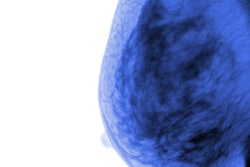
Breast MRI does a better job than mammography in detecting recurring cancer in women who have undergone breast conservation therapy (BCT), according to a study published June 11 in Plos One.
The study results could mean improved long-term outcomes for women who have survived a first incidence of breast cancer, wrote a team led by Dr. Jeongmin Lee of Seoul St. Mary's Hospital in South Korea.
"Previous studies have shown that early detection of second breast cancers can improve the prognosis of patients with recurrent cancer," the group wrote.
Women who have undergone treatment for primary breast cancer remain vulnerable to developing a second breast cancer, both loco-regionally and in the opposite breast, the team noted, and in particular, local recurrence is associated with increased risk of distant metastasis or breast cancer-related death. Typically, women who undergo breast conservation therapy (that is, surgery) to treat primary cancer are followed with mammography, but this modality may miss recurring breast cancer in these patients.
MRI is the most sensitive way to identify breast cancer, and previous research has shown that its detection rate of recurrent cancer post-BCT is more than 90%, according to Lee and colleagues. But breast MRI isn't recommended for routine postoperative tracking in women who have survived a primary cancer -- in part due to its higher cost compared with mammography -- and more data on its performance in identifying recurring cancer is needed.
Lee's group investigated how postoperative breast MRI would perform in women who have undergone breast conservation therapy via a study that included 1,312 women who underwent 2,026 surveillance breast MRI exams after BCT between January 2014 and September 2018. The women also had mammography and ultrasound exams. The researchers defined "early recurrence" as newly diagnosed breast cancer or metastasis within 12 months of surgery and "late recurrence" as the reappearance of disease more than 12 months after BCT.
Of 2,026 breast MRI exams, 103 identified recurrent breast cancer. Of these 103 cancer cases, 31 were early recurrence and 72 were late recurrence.
The researchers found that breast MRI had a higher detection rate for recurrent lesions -- both early and late -- than mammography or ultrasound alone as well as the combination of the two. The modality also found 19 recurring cancer lesions that were not identified at all on mammography or ultrasound.
| Comparison of various modalities' performance for identifying recurrent breast cancer post- BCT | ||||
| Measure | Mammography | Ultrasound | Mammography plus ultrasound | Breast MRI |
| Detectability rate | 59.4% | 68.9% | 81.6% | 99% |
Lee's group discovered that recurring breast cancer lesions did show a particular MRI characteristic -- regardless of whether they recurred within 12 months after surgery or later.
"Early fast enhancement is the most important feature of recurrent lesions on postoperative breast MRI for both early and late recurrence groups," the team wrote.
The study sheds light on the fact that breast MRI is an effective way to surveil women who have survived one bout of breast cancer and suggests the best time frame for this surveillance, according to the team.
"[Our] results are not only a milestone for proving the usefulness of the preoperative breast MRI, but also the basis for determining the appropriate time interval for preoperative breast MRI after BCT," the group concluded.




.fFmgij6Hin.png?auto=compress%2Cformat&fit=crop&h=100&q=70&w=100)




.fFmgij6Hin.png?auto=compress%2Cformat&fit=crop&h=167&q=70&w=250)











